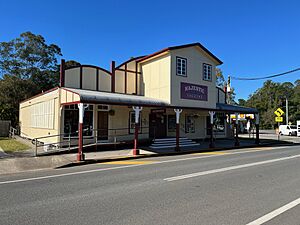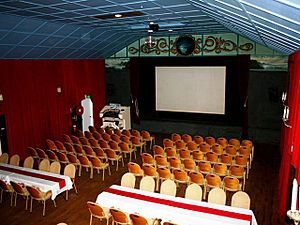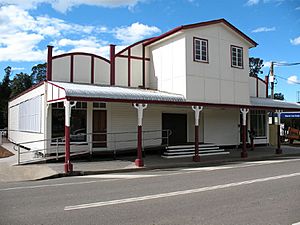Majestic Theatre, Pomona facts for kids
Quick facts for kids Majestic Theatre |
|
|---|---|

Majestic Theatre, 2023
|
|
| Location | 3 Factory Street, Pomona, Shire of Noosa, Queensland, Australia |
| Built | 1921 |
| Official name: Majestic Theatre | |
| Type | state heritage (built) |
| Designated | 5 February 2009 |
| Reference no. | 602696 |
| Significant period | 1920s |
| Lua error in Module:Location_map at line 420: attempt to index field 'wikibase' (a nil value). | |
The Majestic Theatre in Pomona, Queensland, is a very old and special building. It's known as a "heritage-listed" theatre, which means it's protected because of its history and importance. It was added to the Queensland Heritage Register on February 5, 2009. This theatre is famous for showing movies for a very long time!
Contents
The Theatre's Early Days
The Majestic Theatre, located at 3 Factory Street in Pomona, was first built in 1921. It started as a social hall with a few shops attached. People say it's the oldest real silent movie theatre still working in the world. It's also the longest-running movie theatre in Australia! Even though it has been updated, this timber building is a rare example of an old hall that became a movie theatre.
How Pomona Grew
In the 1860s, cutting down trees was the main job in the Pomona area. Later, in the 1890s, some farming groups tried to settle there. The North Coast railway line from Brisbane to Gympie was finished in 1891. A train stop was set up for local farmers to send their goods. This stop was named Pomona in 1900, after the Roman Goddess of fruit. The town grew with hotels and a Shire Council office.
From Timber to Dairy and Fruit
In the early 1900s, the area changed from timber to dairy farming and growing fruit. Butter factories opened nearby, and bananas became a big industry. Dairying was the main industry until the 1960s. By the 1990s, Pomona was known for fruit and making furniture.
Building the Majestic Hall
In 1921, Errol and Myra Osborne, who ran the Railway Hotel, decided to build a hall next to their hotel. Myra's mother, Clara McDonald, bought the land and paid for the building. The hall was finished in late 1921. It was called the Majestic Hall.
What the Hall Was Used For
The hall was built for many things. It showed silent movies, hosted live shows, and was a social spot for the town. People used it for dances, concerts, weddings, roller skating, boxing, and even church services. The hall was about 12 meters wide and 18 meters long. It could seat 198 people. It had a special "sprung" dance floor made of crow's ash timber, which is still there today. The building was raised on stumps to avoid floods.
Shops and Additions
Next to the hall's entrance were small shops. One was the Majestic Cafe, which also served as a general store. The other shop was used by a dentist, a radio shop, and a mechanic at different times. In the mid-1920s, a supper room was added to the side of the hall.
Movies and Modern Changes
At first, travelling "Picture Show Men" brought silent movies to the Majestic Hall. In 1923, Harold "Picture" Page leased the hall and got a theatre license. Early silent films in Pomona were often played with music from a pianola.
The Arrival of "Talkies"
On April 28, 1931, the first "talkie" (a movie with its own sound) was shown at the hall. Around 1933, Ernie Bazzo took over the lease. He upgraded the hall into a theatre by adding a small gallery and a "bio box" (the room where the projector is). In the late 1930s, Bazzo replaced the old canvas seats with seats from the Princess Theatre in South Brisbane.
The Theatre's Golden Age
The Majestic Theatre became very popular, especially during World War II. Soldiers stationed nearby had first choice of seats, and locals sometimes had to watch from outside! After the war, from the 1940s to the 1960s, movies were shown on Wednesday and Friday evenings, and Saturday afternoons. People would often go to the Kia Ora Cafe next door for pies during the movie break.
New Owners and Silent Films
In 1973, Ron and Mandy West started the Travelling Film Festival at the Majestic Theatre. They bought the theatre in 1974. The Majestic was the only movie theatre in the Noosa Shire until 1984. The film equipment was updated in 1980, and a DVD system was added in 2003.
Ron West had worked in theatres since he was young. His wife, Mandy, loved theatre too. In the 1980s, she directed a local theatre group called The Majestic Players. They performed plays and pantomimes on the theatre's stage, which was made bigger in 1979. Famous musicians also held concerts there.
In 1987, Ron West showed a silent movie called The Son of the Sheik. He played music on his restored Wurlitzer pipe organ as the movie played. People loved it! Soon, the Wests decided to only show silent movies. The Majestic Theatre became famous worldwide for its silent films. Schools and tourists from all over visited. Ron West received an award in 2004 for his work in culture and the community.
The Majestic's Special Organ
Ron West loves pipe organs and uses them to play music for the silent films. The theatre has a special 1936 Compton organ from England. It's the only one in a Queensland theatre. Ron and John Brooks rebuilt it between 2006 and 2007. The organ's pipes and other parts are in a special room next to the stage.
Ron also collected parts from other old theatres, like the timber organ grill from the Roxy Theatre in Parramatta. He even saved stage drapes and furniture from famous theatres in Brisbane and Ipswich.
Community Ownership and Upgrades
In late 2006, a community group called Pomona Progress Art Tourism Inc. took over the theatre. They wanted to keep it as an entertainment place for everyone. Ron West stayed on to manage the theatre and play the organ.
Between 2006 and 2007, the theatre got a big upgrade. Workers helped fix the building, replacing the roof, strengthening the walls, and updating the inside. Asbestos boards were replaced with new materials. The old fixed seats were removed and replaced with movable ones. The stage roof was raised, and new sliding doors were added. The old Majestic Cafe became Valentino's Restaurant, and the other shop space became a modern kitchen. The special dance floor was polished, and the toilets and snack bar were updated. New paths and ramps were also added outside.
What the Theatre Looks Like
The Majestic Theatre is a long, rectangular building painted cream with bright red trim. It has a gable roof with corrugated metal. A special "bio-box" sticks out from the front, where the projector used to be. A bull-nosed awning covers the footpath, supported by timber posts. The building is covered with timber boards and sits on low concrete stumps.
Inside, the theatre has a central auditorium. On one side are the restaurant and toilets, and on the other are a cafe, kitchen, organ room, and storage. The small entrance area has a bar and ticket booth. Above the entrance is a "dress circle" (a balcony) with movable seats. The bio-box behind the dress circle now holds the electronic equipment for showing films.
The main auditorium has a flat floor made of crow's ash timber. It has a curved ceiling. At the front is a raised stage with a decorated archway. The white Compton organ console sits to the left of the stage. A special screen on the wall allows sound from the organ's pipes to fill the room. The theatre has movable chairs that can be arranged in rows or stacked away.
The stage has sliding doors at the back that open to an outdoor area. The Valentino's Restaurant area has a decorative design that matches the theatre's old style.
A plaque outside the theatre shows it's part of the Pomona heritage walk. There are also metal stars in the footpath to honor people who have helped the theatre, like Ron and Mandy West.
Why the Majestic Theatre is Special
The Majestic Theatre was added to the Queensland Heritage Register on February 5, 2009, because it's very important to Queensland's history and culture.
A Glimpse into Queensland's Past
The Majestic Theatre has been showing films since 1921. It shows how movie theatres grew in Queensland and how important going to the movies was for people in country towns from the 1920s to the 1950s. The theatre started as a community hall and was later changed to show "talkies." This shows how many halls were turned into cinemas. It also highlights how independent owners ran movie theatres in small towns.
A Rare and Unique Place
The Majestic Theatre is special because it's one of the few old movie theatres from before World War II that is still standing and being used. It's also the longest continuously operating movie theatre in Queensland.
Showing How Theatres Were Built
Even with its recent updates, the Majestic Theatre's layout still shows what a small country theatre, adapted from a hall, looked like. This includes its original shops and supper room. Adding a bio-box and a gallery was a common way to turn a hall into a movie theatre.
Important to the Community
Over the last 20 years, the Majestic Theatre has become a favorite place for people who love silent films. Its popularity helped it get financial support from many people and groups, including local, state, and federal governments, for its upgrades.
Supporters
- Noosa Council
- Noosa FM 101.3 Community Radio
- Pomona & District Community House



